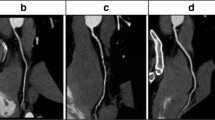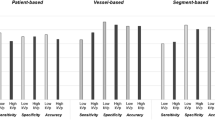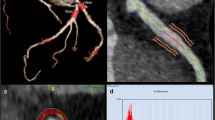Abstract
Objectives
To investigate the effects of low tube voltage on coronary plaques and pericoronary fat assessment, and to compare their extent among various levels of low voltage.
Materials and methods
Patients were recommended for high-pitch low-tube voltage coronary computed tomography angiography (CCTA), and they were included if they had poor image quality and were referred to a conventional CCTA. The patients were classified into a low-voltage group (with 70-kV, 80-kV, and 90-kV subgroups) and a conventional group (100/120 kV). Their total plaque and subcomponent volumes and pericoronary fat attenuation index (FAI) were measured.
Results
A total of 1002 image slices (from 65 patients and 74 plaques) were included, including 21, 31, 13, 4, and 61 patients in the 70-kV, 80-kV, 90-kV, 100-kV, and 120-kV groups respectively. The CT values of noncalcified plaques in the conventional and low-voltage groups were 54.6 ± 21.3 HU and 31.5 ± 22.6 HU, respectively (p < 0.05). Compared with the conventional group, the necrotic core and calcification volume were increased, and the fibrolipid volume, periplaque, and right coronary artery FAI were decreased in the low-voltage group and its subgroups (p < 0.001). The magnitude of changes in fibrous and calcification volumes increased in the 70-kV subgroup compared with that in the 90-kV subgroup (p < 0.05).
Conclusion
Low tube voltages, particularly of 70 kV, have a significant effect on coronary plaque and FAI. The effect of low voltage on plaque composition is characterized by a polarization pattern, i.e., a decrease in fibrolipid (medium density) and an increase in necrotic core (low density) and calcification (high density).
Clinical relevance statement
Our results highlight the comparability and repeatability of plaque and pericoronary fat assessments facilitated by the same or a similar tube voltage. It is necessary to carry out studies on the specificity threshold of low tube voltage at each level.
Key Points
• Low tube voltage had a significant effect on coronary plaque and pericoronary fat, particularly 70 kV.
• The effect of low tube voltage on plaque composition shows the shift from medium-density mixed components to low- and high-density components.
• It is necessary to correct the specificity threshold or attenuation difference for low tube voltage at each level.
Graphical Abstract







Similar content being viewed by others
Abbreviations
- BMI:
-
Body mass index
- CCTA:
-
Coronary computed tomography angiography
- CT:
-
Computed tomography
- DLP:
-
Dose length product
- ED:
-
Effective radiation dose
- FAI:
-
Fat attenuation index
- RCA-FAI:
-
Fat attenuation index of right coronary artery
References
Im DJ, Kim YH, Choo KS et al (2023) Comparison of coronary computed tomography angiography image quality with high-concentration and low-concentration contrast agents: the randomized CONCENTRATE trial. J Thorac Imaging 38:120–127
Wang Y, Chen Y, Liu P et al (2022) Clinical effectiveness of contrast medium injection protocols for 80-kV coronary and craniocervical CT angiography-a prospective multicenter observational study. Eur Radiol 32:3808–3818
Bischoff B, Hein F, Meyer T et al (2009) Impact of a reduced tube voltage on CT angiography and radiation dose: results of the PROTECTION I study. J Am Coll Cardiol Img 2:940–946
Tanami Y, Ikeda E, Jinzaki M et al (2010) Computed tomographic attenuation value of coronary atherosclerotic plaques with different tube voltage: an ex vivo study. J Comput Assist Tomogr 34(1):58–63
Jia CF, Zhong J, Meng XY et al (2019) Image quality and diagnostic value of ultra low-voltage, ultra low-contrast coronary CT angiography. Eur Radiol 29:3678–3685
Wong DTL (2016) Plaque Characterization by coronary computed tomography angiography and association with acute coronary syndrome. J Am Coll Cardiol 67:458–459
Antonopoulos AS, Sanna F, Sabharwal N et al (2017) Detecting human coronary inflammation by imaging perivascular fat. Sci Transl Med 9:eaal2658
Chang HJ, Lin FY, Lee SE et al (2018) Coronary atherosclerotic precursors of acute coronary syndromes. J Am Coll Cardiol 71:2511–2522
Park J, Lee JM, Koo BK et al (2019) Relevance of anatomical, plaque, and hemodynamic characteristics of non-obstructive coronary lesions in the prediction of risk for acute coronary syndrome. Eur Radiol 29(11):6119–6128
Takagi H, Leipsic JA, Indraratna P et al (2021) Association of tube voltage with plaque composition on coronary CT angiography: results from PARADIGM registry. J Am Coll Cardiol Img 14:2429–2440
Masuda T, Nakaura T, Funama Y et al (2019) Does the tube voltage affect the characterization of coronary plaques on 100- and 120-kVp computed tomography scans. J Comput Assist Tomogr 43:416–422
van Rosendael AR, Narula J, Lin FY et al (2020) Association of high-density calcified 1K plaque with risk of acute coronary syndrome. JAMA Cardiol 5:282–290
Sutton NR, Malhotra R, St Hilaire C et al (2023) Molecular mechanisms of vascular health: insights from vascular aging and calcification. Arterioscler Thromb Vasc Biol 43:15–29
Kaiser Y, Daghem M, Tzolos E et al (2022) Association of lipoprotein(a) with atherosclerotic plaque progression. J Am Coll Cardiol 79:223–233
Yamaguchi M, Hoshino M, Sugiyama T et al (2022) Association of near-infrared spectroscopy-defined lipid rich plaque with lesion morphology and peri-coronary inflammation on computed tomography angiography. Atherosclerosis 346:109–116
Lin A, Nerlekar N, Yuvaraj J et al (2021) Pericoronary adipose tissue computed tomography attenuation distinguishes different stages of coronary artery disease: a cross-sectional study. Eur Heart J Cardiovasc Imaging 22:298–306
Oikonomou EK, Antonopoulos AS, Schottlander D et al (2021) Standardized measurement of coronary inflammation using cardiovascular computed tomography: integration in clinical care as a prognostic medical device. Cardiovasc Res 117:2677–2690
Sugiyama T, Kanaji Y, Hoshino M et al (2020) Determinants of pericoronary adipose tissue attenuation on computed tomography angiography in coronary artery disease. J Am Heart Assoc 9:e016202
Ma R, Ties D, van Assen M et al (2020) Towards reference values of pericoronary adipose tissue attenuation: impact of coronary artery and tube voltage in coronary computed tomography angiography. Eur Radiol 30:6838–6846
Etter D, Warnock G, Koszarski F et al (2023) Towards universal comparability of pericoronary adipose tissue attenuation: a coronary computed tomography angiography phantom study. Eur Radiol 33:2324–2330
Mergen V, Ried E, Allmendinger T et al (2022) Epicardial adipose tissue attenuation and fat attenuation index: phantom study and in vivo measurements with photon-counting detector CT. AJR Am J Roentgenol 218:822–829
Zhang R, Ju Z, Li Y, Gao Y, Gu H, Wang X (2022) Pericoronary fat attenuation index is associated with plaque parameters and stenosis severity in patients with acute coronary syndrome: a cross-sectional study. J Thorac Dis 14:4865–4876
Lee SE, Park HB, Xuan D et al (2019) Consistency of quantitative analysis of coronary computed tomography angiography. J Cardiovasc Comput Tomogr 13:48–54
Funding
The authors state that this work has not received any funding.
Author information
Authors and Affiliations
Corresponding author
Ethics declarations
Guarantor
The scientific guarantor of this publication is Zhaoqian Wang.
Conflict of interest
Y.D. is an employee of Siemens Healthineers Ltd. The remaining authors of this manuscript declare no relationships with any companies, whose products or services may be related to the subject matter of the article.
Statistics and biometry
No complex statistical methods were necessary for this paper.
Informed consent
Written informed consent was obtained from all subjects (patients) in this study.
Ethical approval
The approval from the Ethics Committee of the First Affiliated Hospital of Dalian Medical University was obtained.
Study subjects or cohorts overlap
None
Methodology
• prospective
• case-control study
• performed at one institution
Additional information
Publisher's Note
Springer Nature remains neutral with regard to jurisdictional claims in published maps and institutional affiliations.
Zhaoqian Wang is a contributing author.
Rights and permissions
Springer Nature or its licensor (e.g. a society or other partner) holds exclusive rights to this article under a publishing agreement with the author(s) or other rightsholder(s); author self-archiving of the accepted manuscript version of this article is solely governed by the terms of such publishing agreement and applicable law.
About this article
Cite this article
Pan, Y., Gao, Y., Wang, Z. et al. Effects of low-tube voltage coronary CT angiography on plaque and pericoronary fat assessment: intraindividual comparison. Eur Radiol (2024). https://doi.org/10.1007/s00330-024-10648-0
Received:
Revised:
Accepted:
Published:
DOI: https://doi.org/10.1007/s00330-024-10648-0




